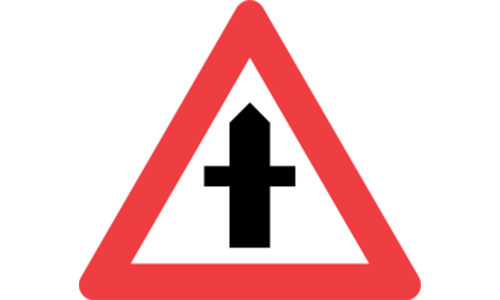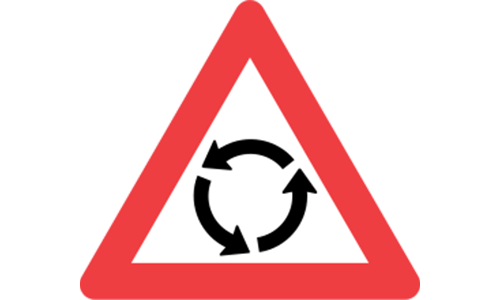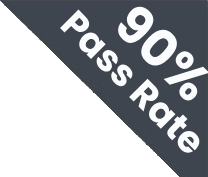Driving Theory Test 1
01/65
1.What does this road sign indicate?

This warning sign, with its depiction of a main road and a smaller intersecting road, indicates a dangerous junction where the road you are on does not have priority over the intersecting road.
01/65
Progress
Driving Theory Test 1
02/65
2.What does this road sign require drivers to do?

This sign indicates that you must give way to traffic on the road you are joining or crossing. You must slow down and be prepared to stop if necessary to allow other traffic to proceed safely.
02/65
Progress
Driving Theory Test 1
03/65
3.Seeing this sign at an intersection, what specific turn are you forbidden to make?

A right turn is prohibited at the junction or intersection where the sign is placed. Drivers must choose an alternative direction of travel.
03/65
Progress
Driving Theory Test 1
04/65
4.What does the round sign with a red border and a red cross through a blue background containing symbols for a bicycle and a moped signify?

This sign specifically prohibits the parking of bicycles and mopeds. It ensures these areas remain clear for other purposes or vehicles.
04/65
Progress
Driving Theory Test 1
05/65
5.Upon seeing this sign, what is the only permitted direction of travel?

Drivers are required to proceed straight ahead. This sign is typically placed at intersections or on one-way roads where other turns, including left or right, are not permitted to maintain a specific flow of traffic.
05/65
Progress
Driving Theory Test 1
06/65
6.What is the required direction of travel indicated by this sign?

This sign indicates that drivers are strictly required to continue straight ahead at the upcoming intersection or road segment. All other movements, such as turning left, turning right, or making a U-turn, are prohibited to ensure a specific traffic flow direction.
06/65
Progress
Driving Theory Test 1
07/65
7.You see a blue motorway sign with A 44 and destinations like Haarlem 23 and Amsterdam 34. What information is it primarily giving you?

This sign provides key navigation details for your journey on the motorway, showing where roads lead and your current motorway number.
07/65
Progress
Driving Theory Test 1
08/65
8.What important commercial facility does this sign direct you to?

This sign indicates the location of a facility specifically designed for the loading, unloading, and handling of large commercial containers and cargo transported by sea, serving as a key point for maritime trade.
08/65
Progress
Driving Theory Test 1
09/65
9.What does a uniformed officer with one arm raised vertically mean?

A raised vertical arm indicates a general stop, requiring all approaching traffic to halt.
09/65
Progress
Driving Theory Test 1
010/65
10.When is it generally not allowed to cross a continuous line that is not at the edge of the carriageway?
Drivers must not cross a continuous line in the middle of the road unless specific exceptions (like entering a hard shoulder) apply.
010/65
Progress
Driving Theory Test 1
011/65
11.What does a red and white triangular sign indicate when approaching an intersection?
These signs, along with white triangles on the road, mean that you must give way to traffic on the road you are about to enter. This ensures safe merging and intersection navigation.
011/65
Progress
Driving Theory Test 1
012/65
12.What is the general speed limit established for driving within urban areas?
The general speed limit in urban areas is 50 km/h. This limit is typically indicated by white plates showing town silhouettes.
012/65
Progress
Driving Theory Test 1
013/65
13.You are riding on a multi-lane motorway. Which lane should you normally travel in if you are not overtaking?
In Netherlands, driving is on the right. You should stick to the rightmost lane unless you are overtaking. The left lanes are for passing only. Failing to return can earn you a fine.
013/65
Progress
Driving Theory Test 1
014/65
14.On which side of the road is stopping and parking generally permitted?
Stopping and parking is as a rule permitted on the right side of the road. This aligns with standard traffic flow rules.
014/65
Progress
Driving Theory Test 1
015/65
15.You are driving through a quiet residential area. When is it generally acceptable to use your horn?
The use of the horn in built-up areas is strictly limited to situations where it is necessary to avoid a collision. Unnecessary or aggressive use of the horn is prohibited and can result in a fine. Think of it as a tool for safety, not communication or expressing frustration.
015/65
Progress
Driving Theory Test 1
016/65
16.Under what circumstances is it permissible to hold and use a mobile phone while operating a vehicle?
The law in Netherlands strictly prohibits the use of any handheld mobile phone or device with a screen while driving or when the vehicle is stopped on the road (except when parked legally). This includes making calls, texting, browsing, or using apps. The prohibition aims to minimize distractions and enhance road safety.
016/65
Progress
Driving Theory Test 1
017/65
17.Are there typically specific speed limits in the immediate vicinity of schools during drop-off and pick-up times?
Many school zones have clearly marked reduced speed limits that are in effect during school hours or at specific times when children are likely to be present. These limits are legally binding, and drivers must adhere to them to ensure the safety of students. Pay close attention to posted signs.
017/65
Progress
Driving Theory Test 1
018/65
18.When approaching a pedestrian crossing, what must a drivers speed adjustment ensure?
At pedestrian crossings, it is essential that speed must be adjusted so as not to endanger pedestrians in the crossing or stepping into it. This prioritizes pedestrian safety.
018/65
Progress
Driving Theory Test 1
019/65
19.What restriction are disabled drivers with a valid badge exempted from?
Disabled drivers with a valid badge are exempt from parking disk zone rules, yellow line bans, and limited parking restrictions for up to 3 hours.
019/65
Progress
Driving Theory Test 1
020/65
20.What extreme penalty might a driver face if caught driving under the influence of alcohol with a very high blood alcohol content (eg, 20 per mille or higher)?
Drivers caught driving under the influence of alcohol with a blood alcohol content of 20 per mille or higher, must expect that their car may be confiscated and auctioned off
020/65
Progress
Driving Theory Test 1
021/65
21.For which occupants in a car are seatbelts compulsory, provided the seats are fitted with them?
Seatbelts are mandatory for all occupants, as they are compulsory for front and rear seat occupants, if fitted. This rule ensures safety for everyone in the vehicle.
021/65
Progress
Driving Theory Test 1
022/65
22.What substances are drivers generally prohibited from operating a vehicle under the influence of?
Driving is strictly prohibited under the influence of impairing substances. One is not allowed to drive under the influence of either alcohol or drugs/euphoriants, underscoring a zero-tolerance policy for impairment on the road.
022/65
Progress
Driving Theory Test 1
023/65
23.When must vehicles and motorcycles use dipped headlamps?
For enhanced visibility at all times, vehicles and motorcycles must use dipped headlamps even by day and in clear weather. This rule ensures vehicles are always easily seen by other road users.
023/65
Progress
Driving Theory Test 1
024/65
24.What should you do if a warning light stays on after you start driving?u00a0
A warning light that stays on could signal a serious issue with your vehicle.u00a0Find a safe space and pull over as soon as possible, and thoroughly check the vehicle to identify the problem.
024/65
Progress
Driving Theory Test 1
025/65
25.What should you do if you are feeling tired before driving?
Driving while tired significantly increases the risk of accidents. It is safest to avoid driving until you are well-rested to ensure full alertness and concentration.
025/65
Progress
Driving Theory Test 1
026/65
26.What is overdriving your headlights?
Overdriving your headlights occurs when your stopping distance exceeds the distance you can see with your headlights, which can prevent you from stopping safely.
026/65
Progress
Driving Theory Test 1
027/65
27.What should you do when an emergency vehicle with flashing lights approaches from any direction?
When an emergency vehicle with flashing lights approaches, drivers must pull over to the shoulder and stop. This action allows the emergency vehicle to pass safely and quickly. Speeding up or continuing as normal can obstruct the vehicles path and endanger lives.
027/65
Progress
Driving Theory Test 1
028/65
28.What is the primary goal when dealing with aggressive driving and road rage?
Avoiding anger and managing stress helps you stay calm and safe, preventing escalation of road rage situations.
028/65
Progress
Driving Theory Test 1
029/65
29.You see a ball rolling onto the road. What is the best action to take?
The sudden appearance of a ball is a strong indicator that a child might follow. Therefore, the safest immediate action is to significantly reduce your speed and be prepared to stop. This allows you to react appropriately if a child unexpectedly enters your path.
029/65
Progress
Driving Theory Test 1
030/65
30.What is the first thing you should do if your car breaks down on a busy road?
If your car breaks down, the priority is to move it to a safe location to avoid obstructing traffic and prevent further accidents. Pulling over to the shoulder and activating your hazard lights makes your vehicle visible to other drivers, signaling that there is a problem.
030/65
Progress
Driving Theory Test 1
031/65
31.What is the primary benefit of accelerating gently?
Gentle acceleration allows the engine to work more efficiently and burn less fuel. Sudden acceleration requires more power and increases fuel consumption. By easing into speed, you reduce unnecessary strain on your vehicle and save fuel over time.
031/65
Progress
Driving Theory Test 1
032/65
32.When driving, what does reading the road ahead primarily involve?
Reading the road means scanning for upcoming changes. This includes curves, lane shifts, and hazards. It helps drivers anticipate and react safely.
032/65
Progress
Driving Theory Test 1
033/65
33.When approaching a 4-way stop intersection, who has the right-of-way?
At a 4-way stop, the fundamental rule is that the vehicle that arrived first and came to a complete stop has the right-of-way. This ensures an orderly flow of traffic.
033/65
Progress
Driving Theory Test 1
034/65
34.When preparing to merge onto a high-speed highway, what is the primary purpose of the acceleration lane?
The acceleration lane is specifically designed to allow drivers to match the speed of highway traffic before entering the main lanes. This ensures a smooth and safe merge, minimizing disruption to existing traffic flow.
034/65
Progress
Driving Theory Test 1
035/65
35.You are driving through a marked school zone during school hours. You see children walking on the sidewalks and waiting near a crosswalk. What is the most immediate and safest action you should take?
In a school zone during school hours, children can be unpredictable. You must reduce your speed significantly and be prepared to stop for unexpected movements, prioritizing their safety.
035/65
Progress
Driving Theory Test 1
036/65
36.You are driving on a rural road at night. There are no streetlights, and you are following another vehicle. What type of headlights should you use?
When following another vehicle at night, you must use your dipped (low beam) headlights to avoid blinding the driver ahead through their rearview mirror. High beams should only be used when no other vehicles are present.
036/65
Progress
Driving Theory Test 1
037/65
37.You are driving on a multi-lane highway, maintaining a safe following distance. Suddenly, the vehicle directly in front of you brakes very hard, causing its brake lights to flash brightly. What is your immediate and priority action?
When a vehicle ahead brakes suddenly, your priority is to brake firmly but smoothly to reduce your speed and avoid a collision. Simultaneously, checking your rearview mirror is crucial to be aware of traffic behind you and potential rear-end collisions.
037/65
Progress
Driving Theory Test 1
038/65
38.You are driving on a road during a heavy rainstorm, and the vehicle ahead kicks up a significant amount of spray, almost completely obscuring your view. What is the safest action to take?
When spray from a leading vehicle reduces visibility, the safest action is to increase your following distance and reduce your speed. This provides more reaction time and safer navigation.
038/65
Progress
Driving Theory Test 1
039/65
39.You are attempting to parallel park on a street between two parked cars. Your vehicle is currently aligned with the vehicle in front of the empty space. What is your next step before reversing?
Before initiating any reverse maneuver, especially in a tight space like parallel parking, its crucial to check your mirrors and over your shoulder to ensure the area behind and around your vehicle is clear of obstacles.
039/65
Progress
Driving Theory Test 1
040/65
40.You approach a pedestrian crossing where a pedestrian is standing on the curb, looking at oncoming traffic. What should you do?
When a pedestrian is clearly intending to cross, drivers must yield and allow them to do so safely. Proceeding without stopping is dangerous and against traffic regulations.
040/65
Progress
Driving Theory Test 1
041/65
41.You are driving and see an orange or yellow sign that says Roadworks Ahead. What does this sign primarily indicate?
Orange diamond-shaped signs are used to warn drivers of construction or maintenance zones ahead. This requires heightened awareness and readiness to adjust speed or lane position.
041/65
Progress
Driving Theory Test 1
042/65
42.You are driving through a busy city center during rush hour. What is the safest driving behavior?
In dense traffic, lane discipline and safe following distance are critical for preventing collisions and ensuring smoother flow.
042/65
Progress
Driving Theory Test 1
043/65
43.You are driving on a multi-lane road and realize at the last second that your intended exit is coming up on the right, but you are currently in the far left lane with heavy traffic. What is the safest action to take?
When you realize an exit too late in heavy traffic, the safest action is to miss the exit and continue to the next one. Abrupt lane changes or cuts are extremely dangerous and can cause collisions.
043/65
Progress
Driving Theory Test 1
044/65
44.You are towing a small trailer on a main road. What is important to remember about your driving behavior?
Towing increases stopping distance. Always brake earlier and more gently to maintain control and prevent collisions.
044/65
Progress
Driving Theory Test 1
045/65
45.When should you use turn signals?
Turn signals should be used before any change in driving direction or lane position to alert other drivers of your intentions, which enhances safety and reduces the risk of collisions.
045/65
Progress
Driving Theory Test 1
046/65
46.What is a fundamental aspect of defensive driving?
Being proactive and anticipating potential hazards from other road users or changing conditions, and being prepared to react safely before problems arise, is fundamental to defensive driving.
046/65
Progress
Driving Theory Test 1
047/65
47.When driving on an expressway, what is the primary purpose of the far-right lane (slow lane)?
The far-right lane on an expressway is generally designated for slower-moving vehicles and is the primary lane for vehicles preparing to exit the expressway.
047/65
Progress
Driving Theory Test 1
048/65
48.When holding the steering wheel for optimal control, what is the generally recommended hand position, similar to a clock face?
The 9 and 3 oclock hand position provides the best control and balance for steering, especially during evasive maneuvers, and allows for proper airbag deployment.
048/65
Progress
Driving Theory Test 1
049/65
49.How frequently should you typically check your vehicles engine oil level?
Its recommended to check your engine oil level regularly, for instance, once a month, and always before undertaking a long journey, to ensure adequate lubrication and prevent engine damage.
049/65
Progress
Driving Theory Test 1
050/65
50.When should tire pressure be measured for the most accurate reading?
Tire pressure should always be measured when the tires are cold (i.e., before driving or after the car has been stationary for a few hours) to ensure an accurate reading, as driving heats up the tires and increases pressure.
050/65
Progress
Driving Theory Test 1
051/65
51.In the unfortunate event of a flat or damaged tire, what is typically the necessary emergency action a driver must take?
When faced with a flat or severely damaged tire, the most practical and often immediate solution for a driver is to replace it with the spare tire that is typically stored in the vehicles trunk or undercarriage.
051/65
Progress
Driving Theory Test 1
052/65
52.If you notice a tire appears noticeably lower than the others, what should you do before starting your journey?
If a tire appears noticeably lower, it indicates insufficient air pressure. Before setting off, it is crucial to check its pressure with a tire pressure gauge and inflate it to the vehicle manufacturers recommended level.
052/65
Progress
Driving Theory Test 1
053/65
53.Before cold winter weather starts, what important liquid in your car engine cooling system should you check carefully?
Before winter hits, its super important to check your antifreeze (coolant). This liquid stops your engines water from freezing when it gets very cold, which could seriously damage your engine. It also helps stop rust inside the engine.
053/65
Progress
Driving Theory Test 1
054/65
54.If you encounter this sign, what road feature are you approaching?

This triangular warning sign with circular arrows is universally recognized. It specifically warns drivers of an approaching roundabout.
054/65
Progress
Driving Theory Test 1
055/65
55.What does this sign advise you about the road ahead?

This supplementary sign warns drivers that a mandatory STOP sign is located approximately 200 meters further along the road. It gives drivers advance notice to prepare to stop completely at the upcoming junction or crossing.
055/65
Progress
Driving Theory Test 1
056/65
56.Which turn is explicitly forbidden at this junction by this sign?

A left turn is prohibited at the junction or intersection where the sign is placed. Drivers must choose an alternative direction of travel.
056/65
Progress
Driving Theory Test 1
057/65
57.What is the primary regulation within the zone you are entering?

This sign indicates the beginning of a zone where parking is prohibited. This means vehicles are not allowed to be parked on the road within the designated zone, though brief stopping for pick-up/drop-off might be permitted depending on local rules, unless further restricted.
057/65
Progress
Driving Theory Test 1
058/65
58.What is the required maneuver indicated by this sign?

Drivers are required to turn left at this junction. This mandatory instruction ensures vehicles follow a designated route, often to prevent congestion or direct traffic away from restricted areas.
058/65
Progress
Driving Theory Test 1
059/65
59.What maneuver are you explicitly instructed to make by this sign?

This sign explicitly requires drivers to turn left at the indicated junction or intersection. It means that proceeding straight, turning right, or making a U-turn are not allowed, guiding traffic into a specific turning maneuver.
059/65
Progress
Driving Theory Test 1
060/65
60.You see a blue motorway sign with 1200 m, an exit name like Terlet, and an airport symbol. What does this sign indicate?

This sign provides early warning for a motorway exit, indicating the distance to it and the destinations accessible via that exit, including an airport.
060/65
Progress
Driving Theory Test 1
061/65
61.If you encounter this sign, what mode of transport does it indicate is available across water?

This sign points to a water crossing service that is exclusively intended for individuals traveling on foot or by bicycle, offering a dedicated passage over water.
061/65
Progress
Driving Theory Test 1
062/65
62.What should traffic approaching from the front do when the officer has one arm extended straight toward them?

An extended arm facing the oncoming lane means vehicles from the front must stop.
062/65
Progress
Driving Theory Test 1
063/65
63.Which of the following permits crossing a continuous line?
One exception to crossing a continuous line is to enter or exit a hard shoulder, refuge section, or rush-hour lane.
063/65
Progress
Driving Theory Test 1
064/65
64.Upon entering a new road, what action is required if you encounter white triangles painted across your lane?
A line of white triangles across the road signifies that you must give way to traffic on the road you are entering. This is a visual cue for yielding.
064/65
Progress
Driving Theory Test 1
065/65
65.On roads outside of urban areas, what is the standard speed limit for cars and coaches?
The general speed limit on other roads, outside urban areas, is 80 km/h for cars and coaches. This applies to normal roads and dual carriageways.
065/65
Progress
- 1
- 2
- 3
- 4
- 5
- 6
- 7
- 8
- 9
- 10
- 11
- 12
- 13
- 14
- 15
- 16
- 17
- 18
- 19
- 20
- 21
- 22
- 23
- 24
- 25
- 26
- 27
- 28
- 29
- 30
- 31
- 32
- 33
- 34
- 35
- 36
- 37
- 38
- 39
- 40
- 41
- 42
- 43
- 44
- 45
- 46
- 47
- 48
- 49
- 50
- 51
- 52
- 53
- 54
- 55
- 56
- 57
- 58
- 59
- 60
- 61
- 62
- 63
- 64
- 65
0 Correct
x 0 Incorrect
- Passing Score 80%

Ace the DMV Exam on Your First Attempt
Unlimited mock tests
Access Over 1000 Exam Like Questions for Just $3

Ace the DMV Exam on
Your First Attempt

 Pass the Exam easily with Premium Practice Tests | Unlock All with 7 Days Plan
Pass the Exam easily with Premium Practice Tests | Unlock All with 7 Days Plan  Offer Ends in
Offer Ends in 
